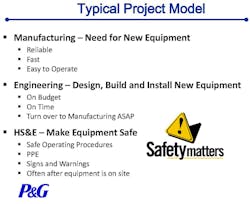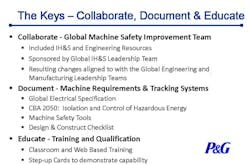“I’m not really an HSE professional,” explained Shawn Hopkins, global behavior and culture safety leader at Procter and Gamble (P&G). “I’m really an engineer in an HSE leadership role.”
On the literal level, this is a perfectly valid statement – Hopkins is a chemical engineer by training and has spent the majority of his 22-year career at P&G working in that capacity. But more broadly, that statement, which opened Hopkins’ packed “Cross-Functional Safety: EHS Professionals and Engineering” presentation at ASC 2013, encapsulates the essence of P&G’s safety program.
Over the past few decades, P&G totally has restructured its internal safety and engineering teams across its wide global footprint, taking them from a disparate pair of bickering groups into one consolidated organization.
“The way we’re organized,” Hopkins explained, “the entire HSE organization is part of the engineering organization.”
In fact, he added, at P&G, “HSE is considered an engineering discipline.”
This collapse and consolidation, he said, has revolutionized the company’s safety standards and set a new model for the industry to follow.
Bridging the Gap
P&G is a safety-first organization, Hopkins explained. For them, staying true to that mission meant ensuring that both sides of this historically incompatible safety/engineering relationship have the same goals and objectives to guide them through every project.
“P&G is committed to having every employee understand and be responsible for incorporating safe behavior in daily business activities,” Hopkins said. “Every employee is trained to work in a safe and healthy manner.”
However, corporate value statement s like this aren’t enough to align the sides, explained Hopkins’ co-presenter, Mark Lewandowski, who’s a control and information system technology leader at Procter & Gamble. No matter the higher level concerns and health and safety objectives, he said, on their own, manufacturers, engineers and safety professionals always will serve different immediate goals:
In this typical layout, “HSE gets involved too late; in many cases, after the equipment is delivered and onsite,” Lewandowski explained.
“How much impact can HSE make in the safety system and design of machinery if they’re not involved until the equipment is delivered on site?” he asked. “That’s just not a sustainable model.”
And so, P&G developed a different model – collapsing safety into the engineering department to ensure that its HSE team’s concerns are brought into the discussion right from the conception.
Doing so has brought these “safety first” slogans and clichés to life in exiting new ways, while eliminating the safety lags in equipment design.
It all starts with a committee.
Machine Safety Improvement Committee
“To get us started, we charted the ‘Machine Safety Improvement Team,’” Lewandowski explained. “This was a cross functional team of industrial safety and engineering and some manufacturing sources as well. We wanted to make sure we had input from all of the organizations.”
That team, he said, was chartered with the responsibility to develop and deploy machine safety training systems and tools to enable them to a couple of interesting things within P&G.
Specifically, the committee brought EHS to the fore at every stage of design in three ways. (See below)
Of these, he said, documentation stands out as a powerful tool to help shore up and ensure safety in design.
In the old system, EHS or HSE teams were the last to sign off on a new machine after it was delivered, long after the design process was completed. But that is no longer the case at P&G. Safety leaders now are required to sign off on every step of the process, every element of the design from concept to creation to delivery.
And that is a powerful thing.
Doing so, Lewandowski explained, helps keep safety in the discussion all the way through the design process.
On the design stage, he said, it’s easier and less expensive to make changes. Engineers and safety leaders can work together to make safer, stronger designs faster and more efficiently than either side could alone. It brings “safety-first” all the way to the blueprints.
Then, by extending these forms to OEEs and vendors who make the machines provides a legal contract for them to implement the necessary machine safety requirements. It is easier to hold vendors accountable when it’s on the floor than when it’s on your own site.
And then finally on the site, it helps make sure that all of those requirements have been met.
“At the end, safety and manufacturing resources are responsible to make sure that everything has been completed and signed off before they even accept the equipment into this site,” Lewandowski said. “So they’re going to hold engineering responsible and accountable when it’s delivered to their site.”
“One of the common values we have is making the safe way the easy way,” Hopkins concluded.
“Know the risk, design out the risk. Know the standard, design for the standard,” he said. “That’s how we work together and deliver the HSE vision for the company.”


